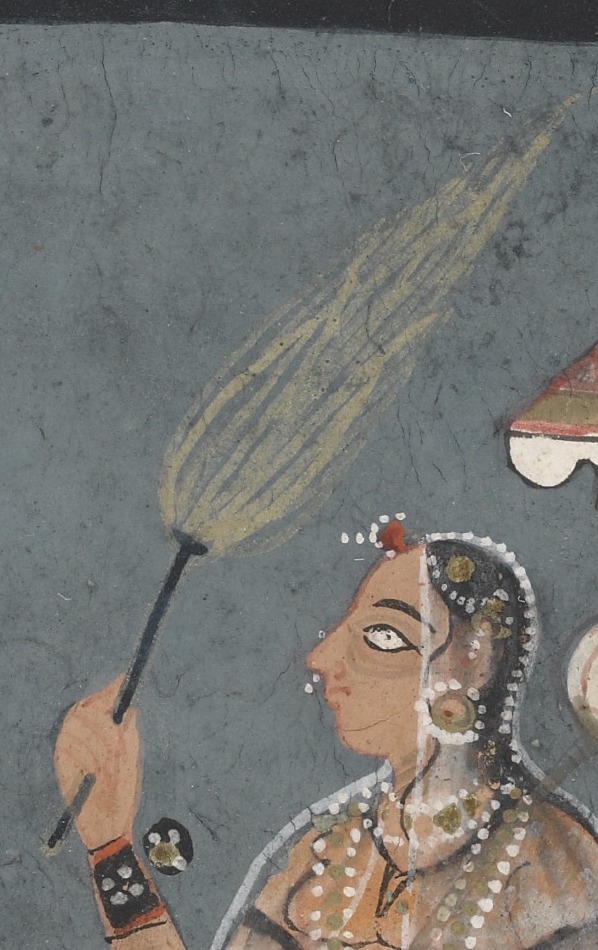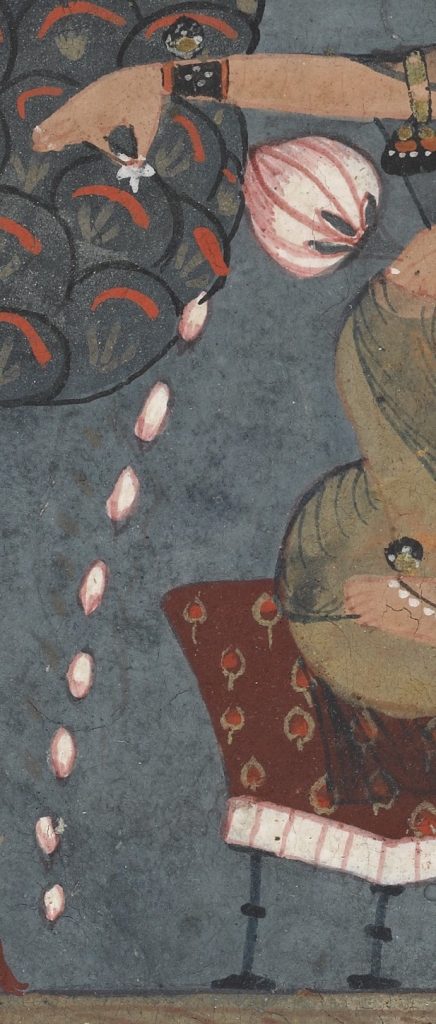Malasri Ragini
Malasri Ragini
India, Madhya Pradesh, Malwa, ca. 1640
Opaque watercolor and gold on paper
Courtesy the Freer Gallery of Art, Smithsonian Institution, Washington, D.C.: Purchase — Charles Lang Freer Endowment, F1924.7
Ragamala painters sought to evoke emotion visually through colors, shapes, and iconic subject matter. The artist’s use of texture and sweeping brush strokes carry the mood of the ragini as much as the characters’ gestures and demeanors. The musical mode Malasri Ragini visualized in this painting is embodied in the maiden who deeply misses her lover and aches for him to return. The heat of her passion and the heat of the night are being fanned away by her confidante.
Malasri sits outside the palace in a walled garden at night. The trees are full and green, with waving branches. Clouds are depicted as a shallow scalloped band at the top of the image, suggesting that the monsoon season is either ending or about to begin. The palace interior color is the red of passion but lacks the bed that typically appears in romantic images. On the floor of the palace are drink containers and bowls of past encounters indicating the recent departure of her lover.

This unusual looking fan is a fly whisk (chauri) made of the hairs from a yak tail. On a practical level they are used to swat away insects. Symbolically, however, they are closely associated with royalty and elite status. As early as the second century BCE, kings and queens are visually indicated by the presence of attendants carrying fly whisks and umbrellas.
The inside of the palace room viewed from the garden is significant from a temporal and evidentiary perspective. Because the lover is absent and the bed cannot be seen, the painting implies a significant passage of time since the two were together. The forgotten or overlooked vases or jars, perhaps for wine and betel nut (paan) show that the room was once busy with love and passion.
Malasri is holding and pulling petals from a lotus flower while sitting next to a pond filled with blossoms. Lotus flowers are symbols of purity and fertility. The time she has been in this state of forlorn longing is indicated by the beautiful arcing row of falling lotus petals. Her forefinger and thumb are holding the petal in a very deliberate, thoughtful manner as if using the flower as an instrument of fate in the chant, “He loves me, he loves me not.” The maiden has been at this task for some time.

Malasri Ragini is deliberately and delicately plucking each petal from the lotus blossom. Her thumb and forefinger are in the shape of a circle, indicating great care and purpose during the act. The string of plucked and falling lotus blossoms is an indicator of the passage of time, since the departure of her lover.
The Hindi couplet written on the reverse says that Malasri and her maids smell of lotus blossoms and dream of their lovers even in the daytime. The scene is nighttime, but the emotion of missing your lover is timeless, and this musical ragini could be played at any time of day. Uniquely, only three notes or swaras are played in Malasri Raginis but those three notes strongly evoke the feeling of longing. Although the musical forms of ragas or raginis are uniquely Indian, the mood or essence of love and longing is musically universal.
